On Saturday at prime time, Granada hosted the current Spanish champion, Barcelona. Even though Barça had their problems early on in this season, the expectancy was that they would take home a clear win, as they were strongly suggested as favourites. However, Granada were able to beat the Cataláns with a score of 2-0 and are now even occupying a Champions League seat, having earned ten points in five games. Barcelona on the other side are stuck with only seven points. They also conceded their ninth goal in the fifth La Liga game this season, being the team with the worst defence in the league. The score along with the unconvincing game they played slowly but surely increases the pressure upon Coach Ernesto Valverde.
Our tactical analysis will explain how Granada were able to beat Barcelona thanks to the tactics of Diego Martínez. The analysis will show up weaknesses in Barcelona’s game, which clever sides like Granada can exploit.
Line-Ups
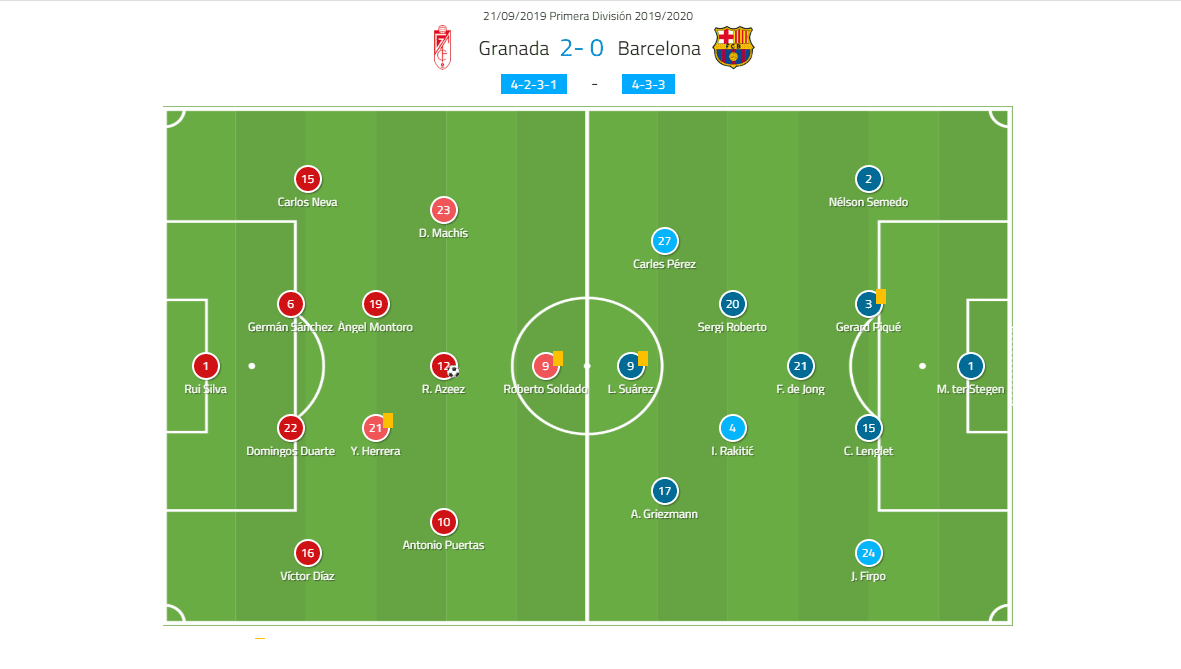
For Granada, left-back Quini and central midfielder Yan Brice Eteki were ruled out. Yangel Herrera in the defensive midfield position turned out to be more than a replacement, having played a brilliant game. The same applies for Ramón Azeez who played as a central advanced midfielder instead of Carlos Fernández, who one might have rather expected in the starting XI. Coach Diego Martínez used a conservative, but effective 4-2-3-1 system which suits his team well.
Ernesto Valverde decided to stick to the 4-3-3 but tried to rotate the personnel after a stressful European game against Dortmund on Tuesday. Sergio Busquets was rested which made Frenkie de Jong occupy the holding midfielder position. As Jordi Alba was ruled out, the new signing from Real Betis, Junior Firpo, started as left-back. 16-year old newcomer Ansu Fati also found himself on the bench to rest, so Antoine Griezmann on paper moved to the left wing while Luis Suárez played as the central striker. Lionel Messi again started from the bench, coming back from an injury.
Firpo’s error leads to an early lead for Granada
Already in the first minute of the game, Jordi Alba’s replacement, Junior Firpo, made a crucial error which ended with the opening goal for Granada. One can imagine how huge an impact that early goal had on how the game later evolved.
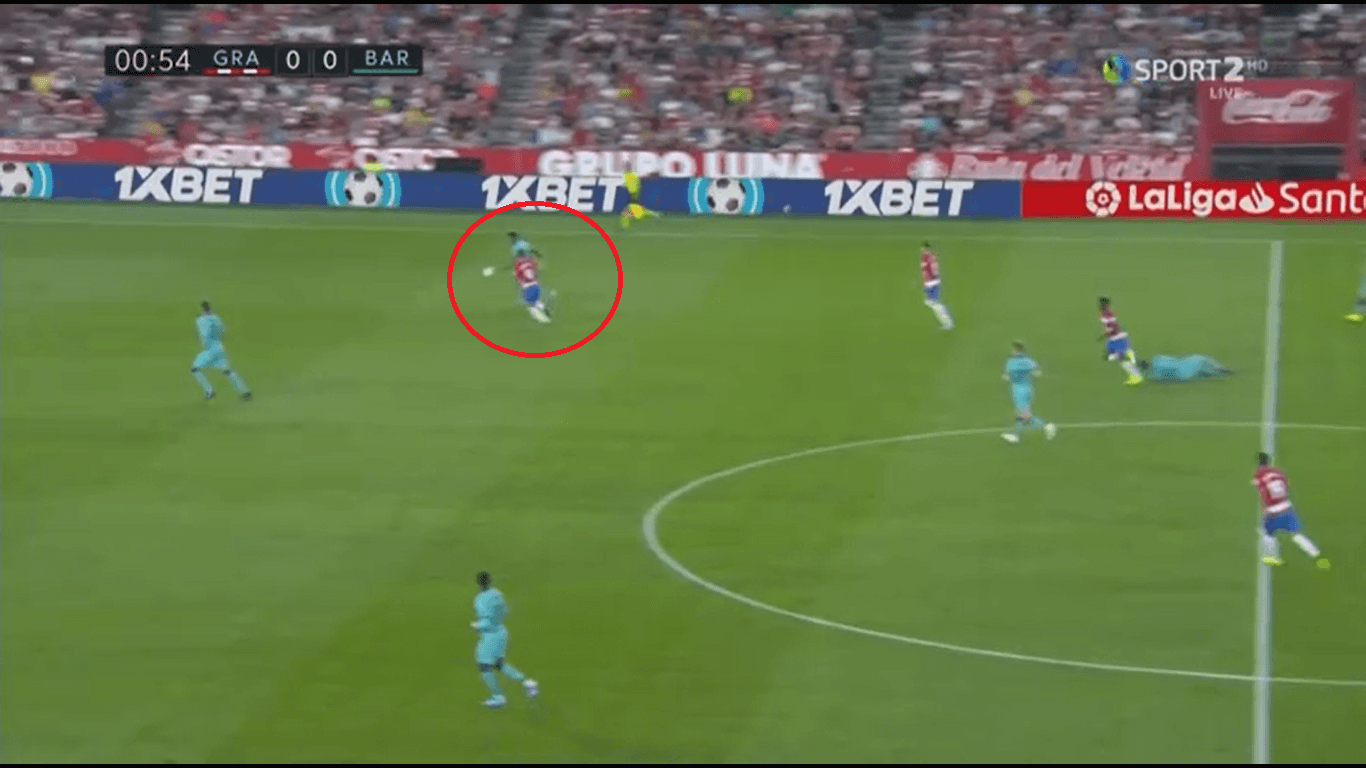
In the image above, we see that after underestimating a long chipped ball, Firpo has to chase the ball faced towards his own target. The position is still not dangerous though, as goalkeeper Marc André ter Stegen and centre-back Gerard Piqué were nearby. However, as Firpo turned the ball over, Roberto Soldado was able to gain possession of the ball.
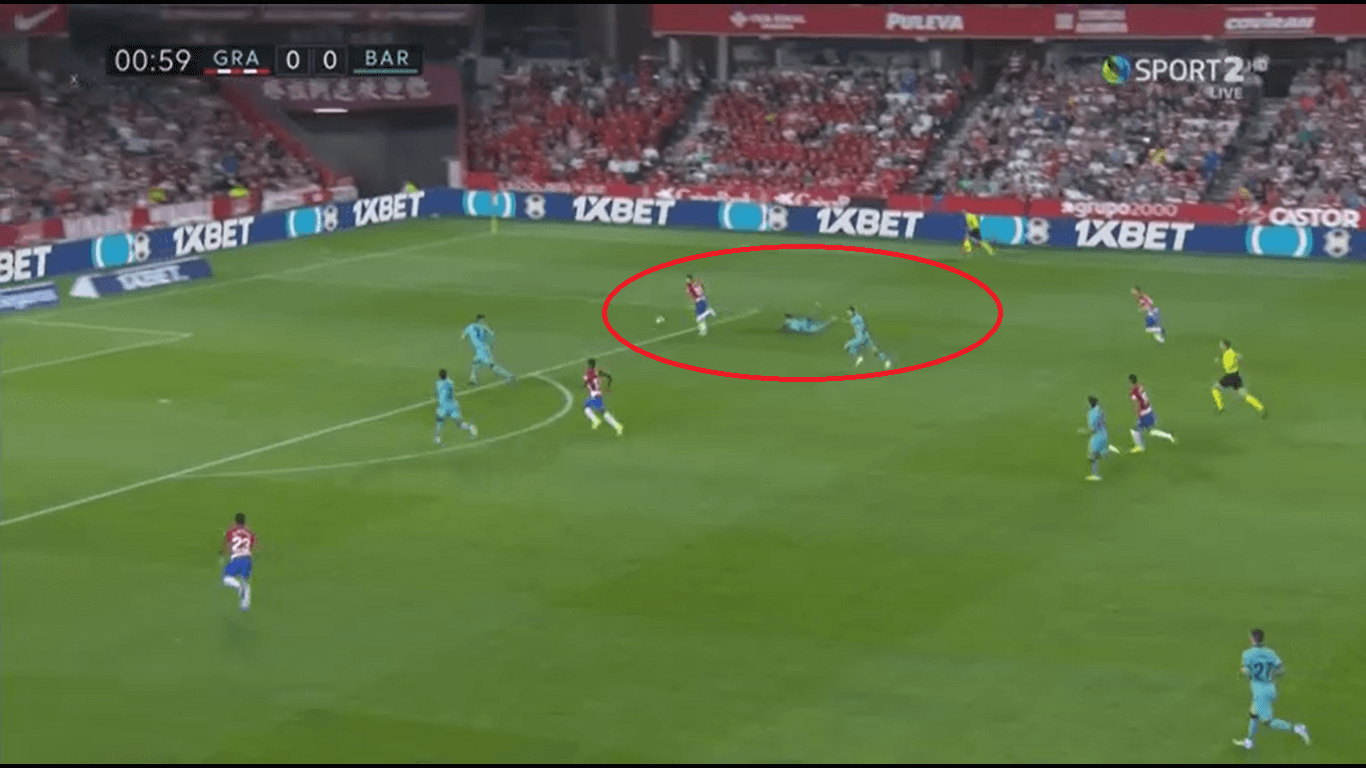
A few seconds later, Firpo lost balance and fell, which resulted in a 3 vs 2 situation for Granada and ultimately ended with the opening goal of the evening.
Granada’s strong defence was the key
Barcelona had only three shots on target during the 90 minutes, and one of the main reasons for that was the great defensive structure by Granada. Most of the time, they defended in a 4-4-2 with a lot of staggering.
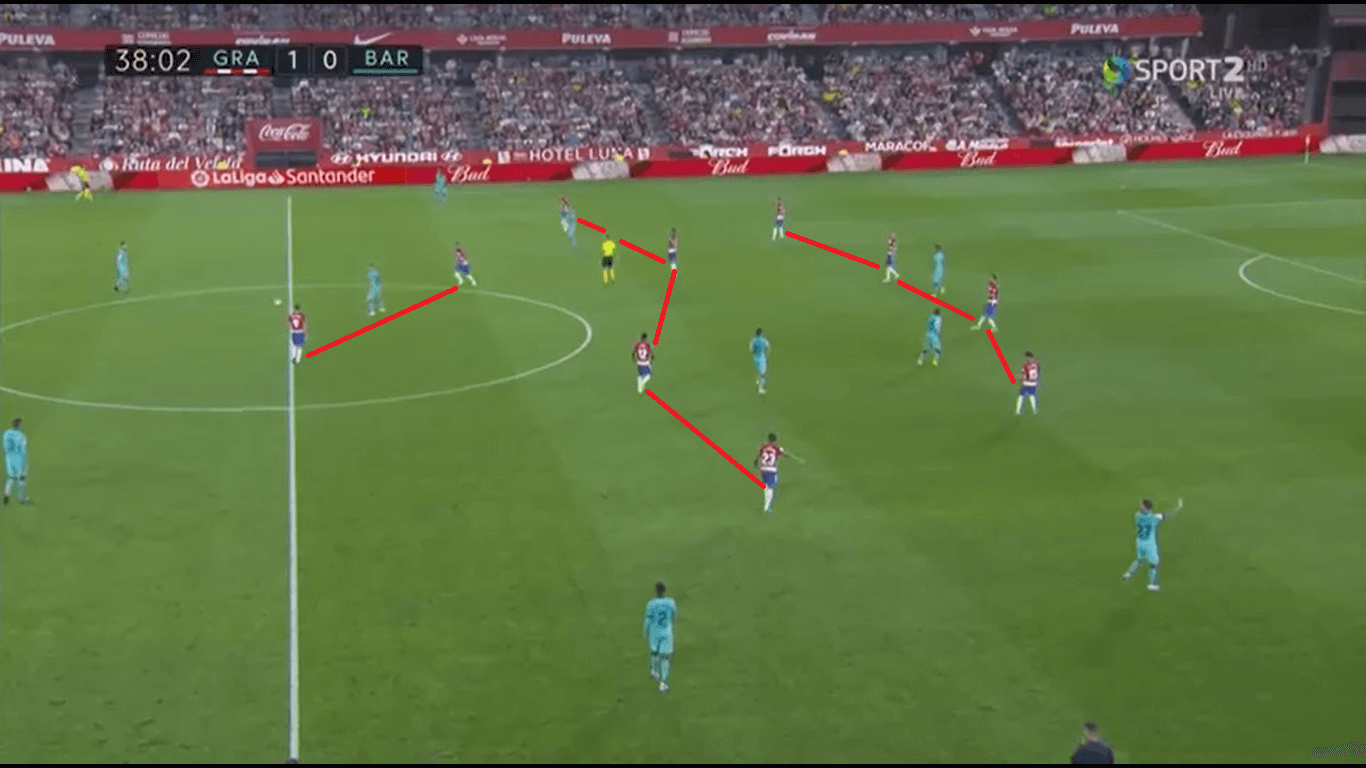
Like in the image above, the striker Soldado and one midfielder (in this case Herrera) were up front and they would never stay on the same line but staggered in order to defend more space. Occasionally, as we will show later, they also pressed the two centre-backs of Barcelona. Here, however, they focussed on controlling Frenkie de Jong. Also, if we look at the midfield line, they are not on one single line either. This allowed Granada to also cover the space between the lines.
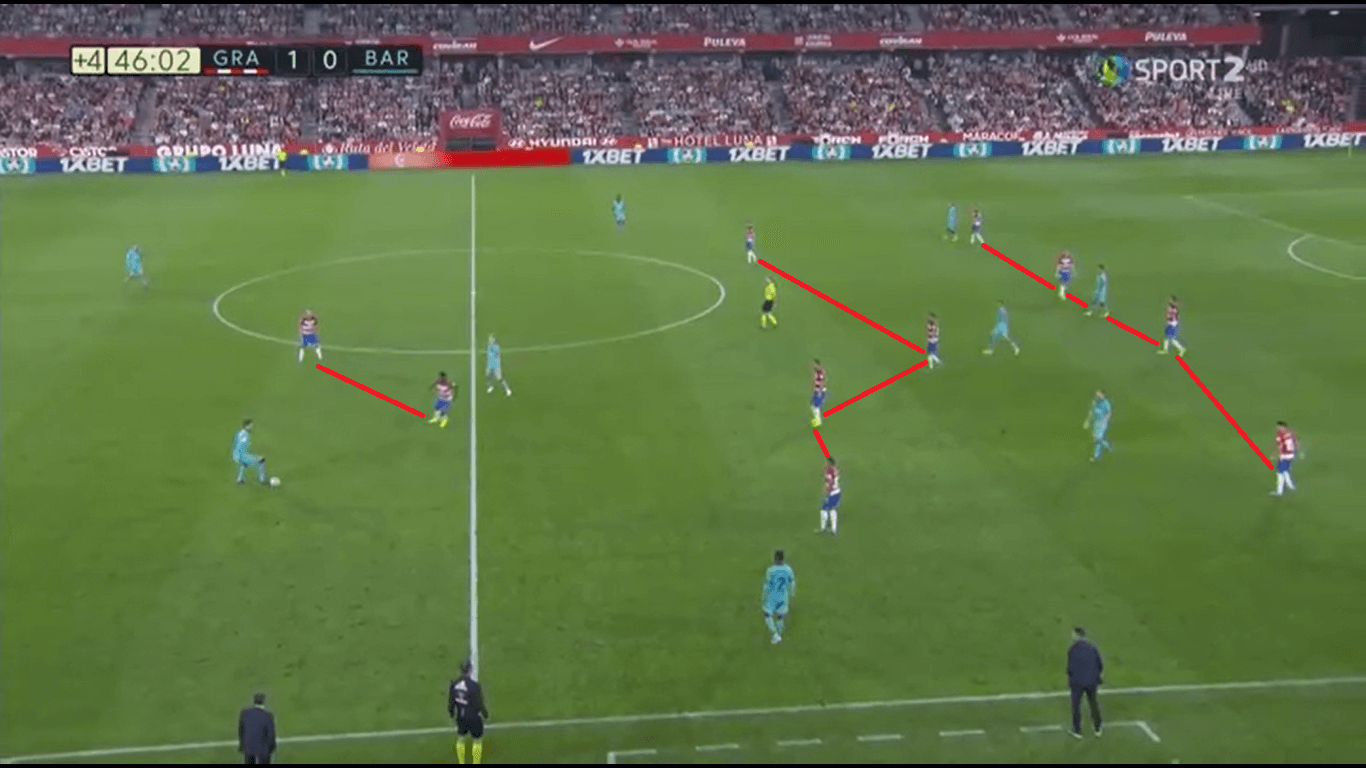
Here, we have one further example. Notice how the two up front close the passing option in the centre and force Piqué to play on the right wing. The midfield line is once again staggered, so it becomes incredibly difficult for Barcelona to get the ball between the lines.
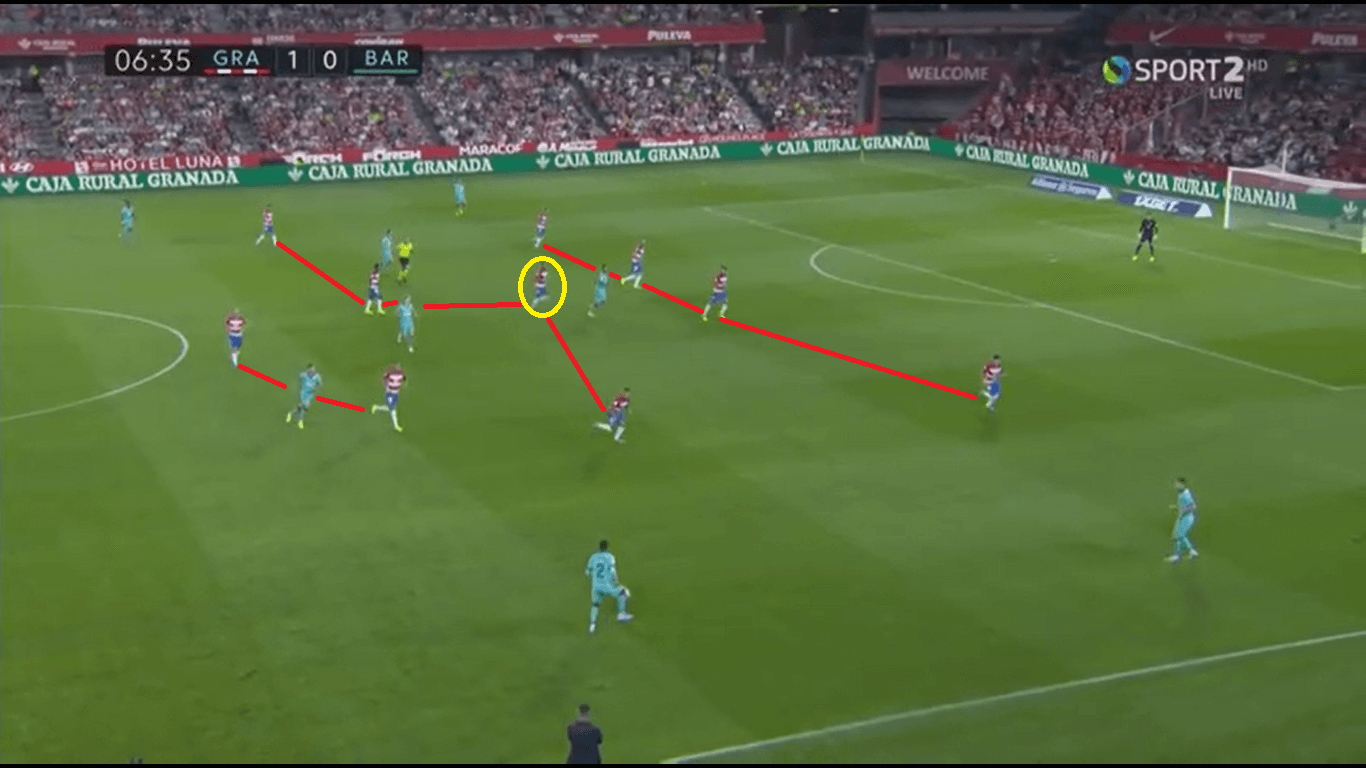
In any case, Granada would stick to these principles. Even when Suárez just fell back a little, a central midfielder would drop to not let him get the ball between the lines, like in the image above. Once again the two strikers up front control the defensive midfielder and Granada as a whole defend the centre of the pitch beautifully. It is also notable that they did not defend too deep but rather had a solid height with their back line.
Granada’s press fulfilled its purpose
Occasionally, Granada would also press higher up the pitch, somewhat aggressively. While they surely speculated on gaining possession in critical areas near the opponent’s target, like with their first goal, their main goal seemed to put Barcelona under some stress and keep them away from the target.
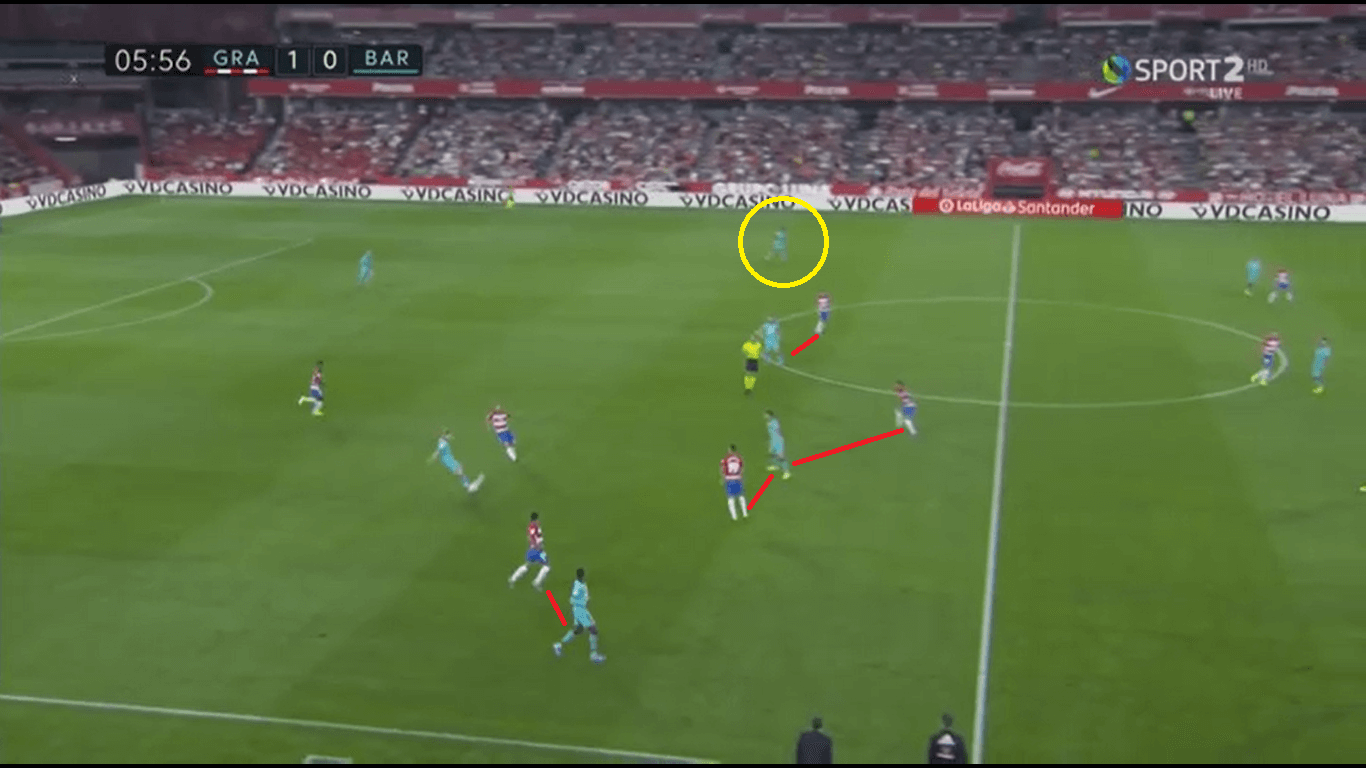
As an example, we have a situation in the image above with Granada closing the nearby passing options for Barcelona intensely, while leaving the left wing wide open. Due to Frenkie de Jong’s individual class, winning the ball there is extremely difficult, but with every opponent near the ball being marked tightly and in some cases even with two defenders, Granada posed a difficult task for de Jong to solve in the position. His best bet is to chip the ball to the left wing, which he is able to do. As such balls have a long flight time though, Granada are able to move to the wing on time to oppose Firpo.
Even later in the game, they did this despite being in the lead.
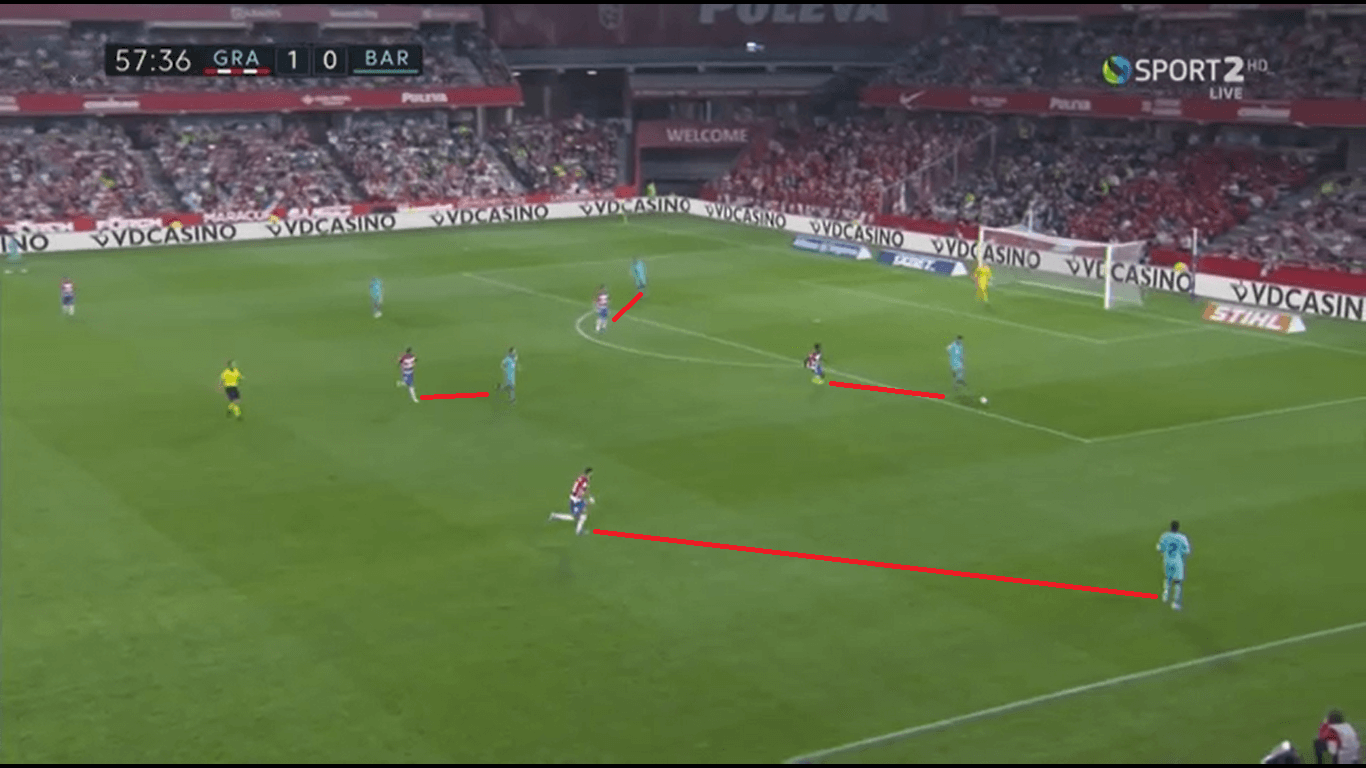
Again, every opponent is marked and the pass to the wing is the only option. While Barcelona have the quality to outplay such a press, it is still a lot more work for their defenders compared to when they can build up without pressure. Thus, Granada used the press from time to time, without exaggerating it in order not to get too tired. They knew exactly when to press and when to fall back.
Barcelona lacked passing angles
Against Granada’s press, Barcelona were not always fully prepared to find the best solution though. While we analysed earlier how Frenkie de Jong was able to do exactly that, other players in Blaugrana were not. The following example demonstrates this.
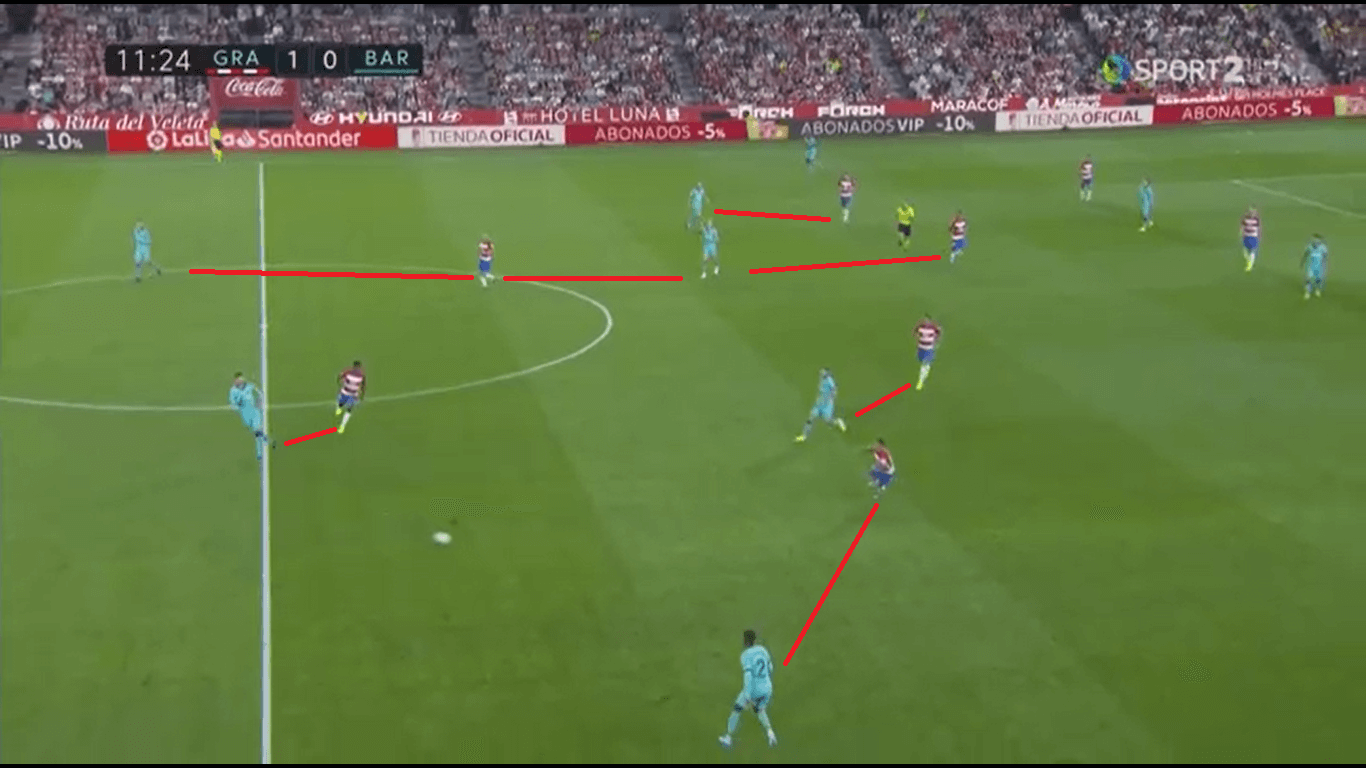
Once again, Barcelona are pushed to the wings. Piqué has to play the ball out to Nelson Semedo, who is immediately pressed by an opponent. Semedo does not have any passing options visible to us in this image, as every player is tightly marked. Even though there is some space between the forward and midfield line, Barcelona’s midfielders occupy the same line and do not provide any passing angles, resulting in no passing options. However, as the next image shows, Granada gave them a passing option along the longline.
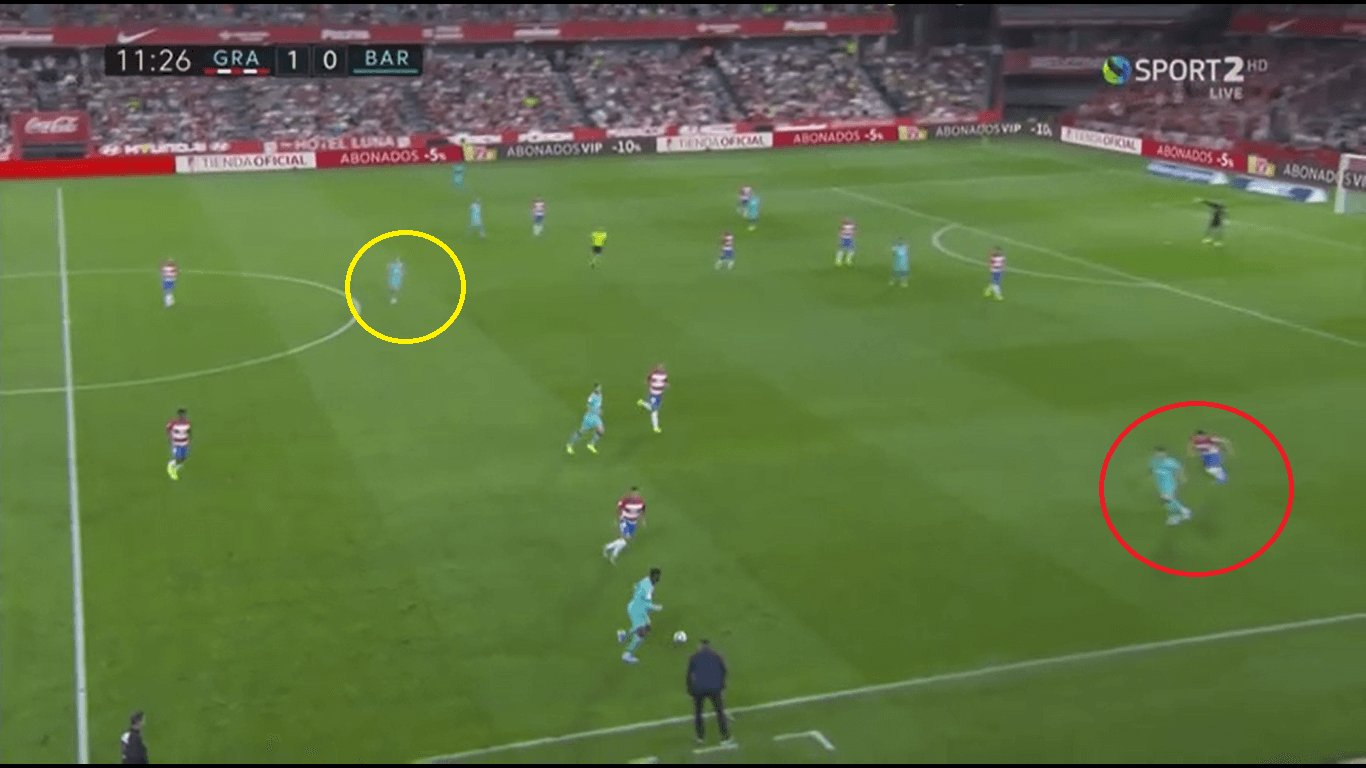
Here, we see now that the longline pass is possible- unfortunately, the pass ended up being poor. This pass is the easiest to defend as it does not involve complex movement, shifting etc. The defender just has to give the ball receiver some pressure, so that an easy first touch is not possible, making sure the attacker stays with his back towards the target and cannot turn. Instead of playing such a dead ball, Semedo should have broken the play and tried to get the ball into the centre, where de Jong is wide open (circled in yellow).
A similar example can be seen in the image below. Once again Semedo plays a vertical pass longline, which does not force the defence into some complex movement, trying to create gaps within the structure. Granada can easily stay in their structure and the attacker cannot do anything dangerous near the sideline with his back towards the target.
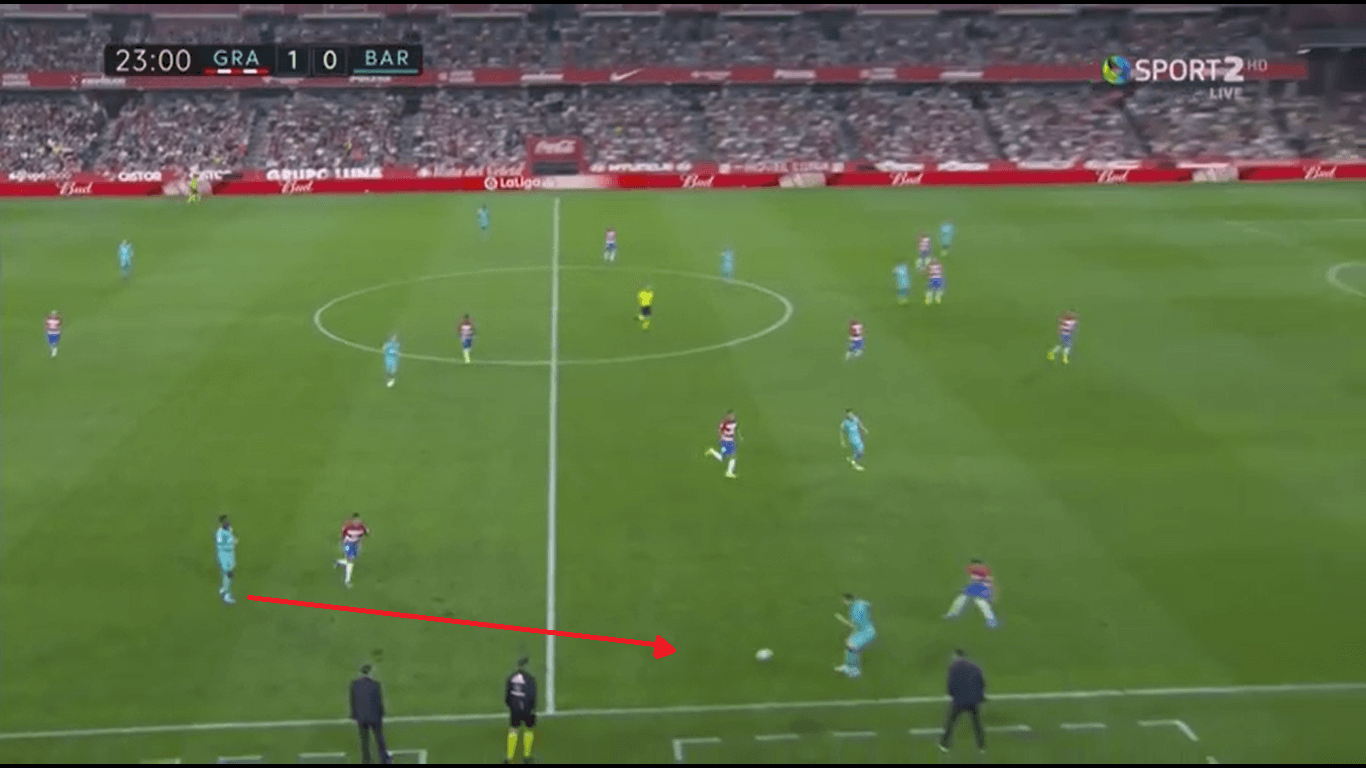
While such passes on the wing do not prove to be good in order to create gaps, they are not very risky either. Playing vertical passes in the centre involves some kind of risk though. For instance, let’s look at the image below.
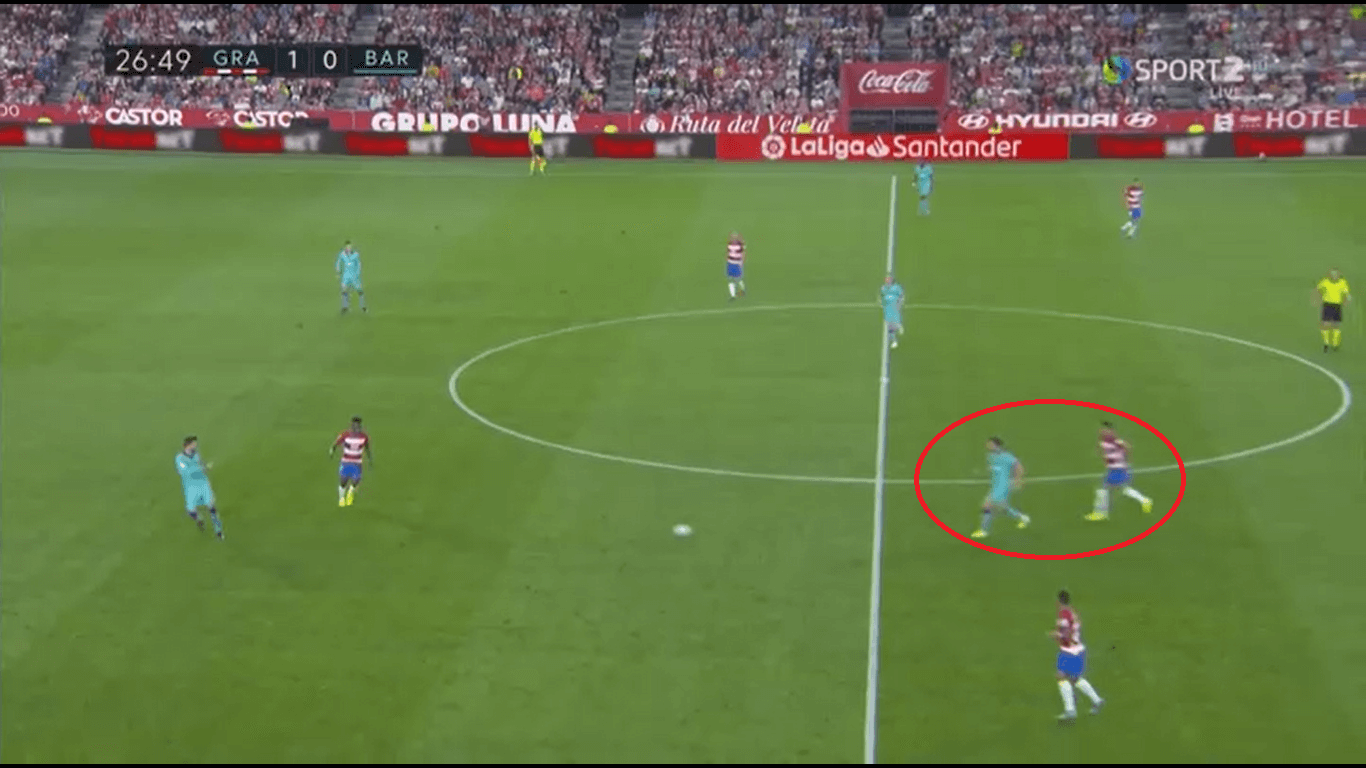
Piqué has to deal with pressure, so he plays a vertical pass into the centre. Sergi Roberto is immediately under a lot of pressure and has to be very careful, as losing the ball there would immediately result in a 3 vs 2 inferiority for Barcelona. Here, Roberto secured the ball by playing it back, but in other cases this could go terribly wrong.
One positive example of how to do it better is once again shown by Frenkie de Jong.
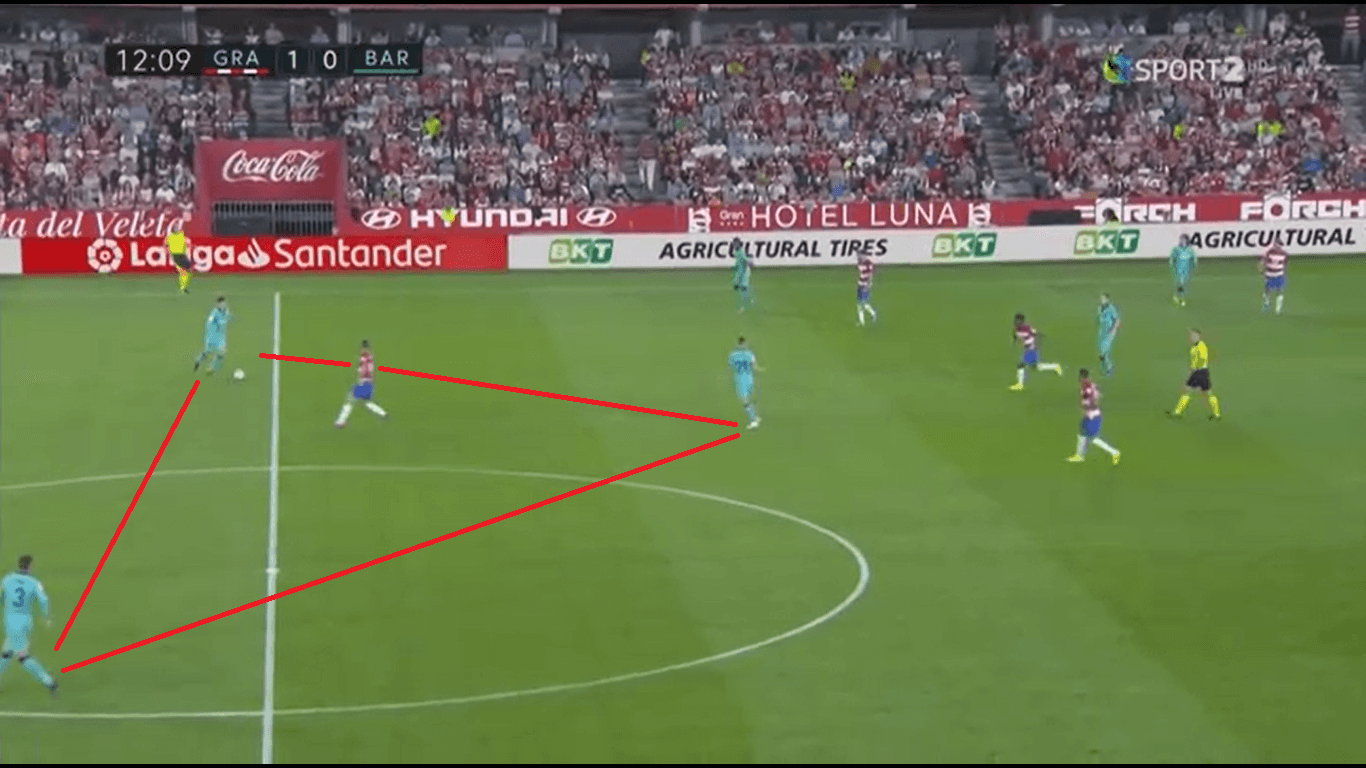
Here, we see how de Jong always tried to create triangles with both the centre-backs. Additionally before he receives the pass, de Jong catches a quick look over his shoulder and thus, he is fully aware of all the possible threats and reacts quickly to the opponent’s press.
Barcelona’s positioning between the lines remains a key issue
As mentioned before, Granada did great to prevent Barcelona from getting the ball between the lines. However, there were situations where Barcelona did a somewhat better job in positioning. We can see this in the situation below.
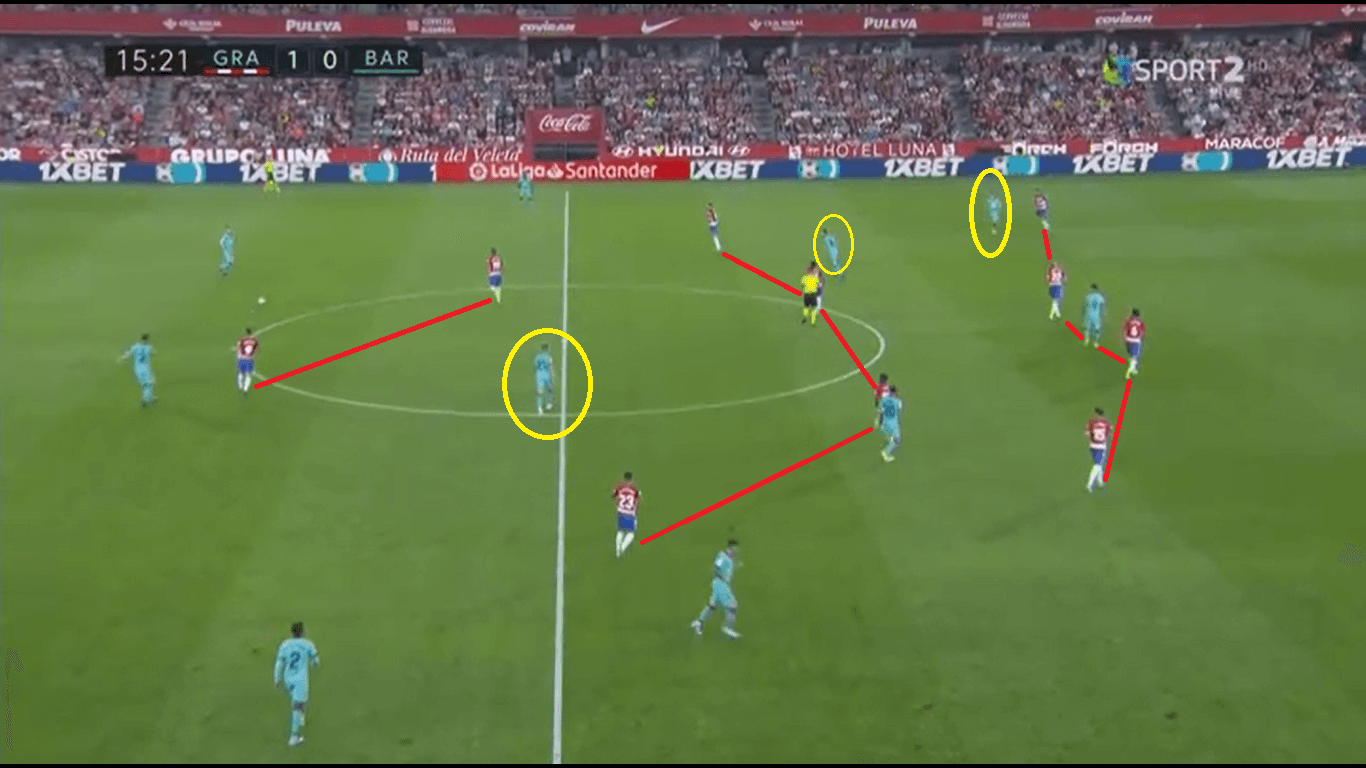
Frenkie de Jong does a great job here to position himself between the two strikers and the midfield line. Ivan Rakitic and Antoine Griezmann are between the midfield and back line, even though they occupy the same space. In the right half-space, Sergi Roberto could move a bit more into the space between the lines. While Barcelona were in parts able to position better on some occasions, there still was a lot of room for improvement.
In the second half, Valverde reacted early on and brought in Lionel Messi and Ansu Fati. The system was changed to a 4-2-3-1.
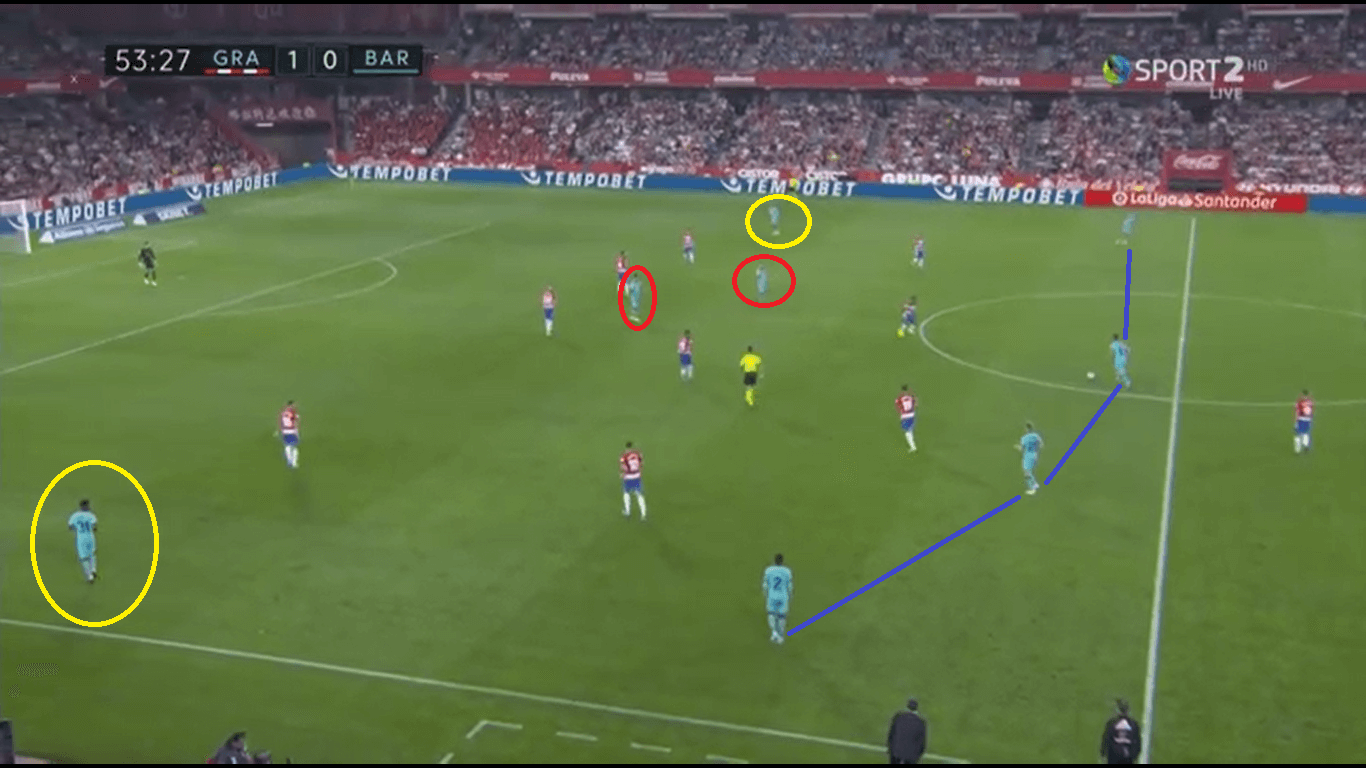
Like in this image, Fati stayed extremely wide on the left wing. Griezmann moved into the centre behind Suárez, after being quite isolated on the left wing in the first half. The idea behind this move was specifically to bring Griezmann in better positions in this exact space between the lines where he is strong. Messi, who also loves to operate from that space, as always had a free role and could basically do whatever he thought was best.
Granada reacted to this late in the game. While they tried to prevent passes between the lines with staggered positioning for a long time, the second idea of a 4-1-4-1 structure worked just as fine.
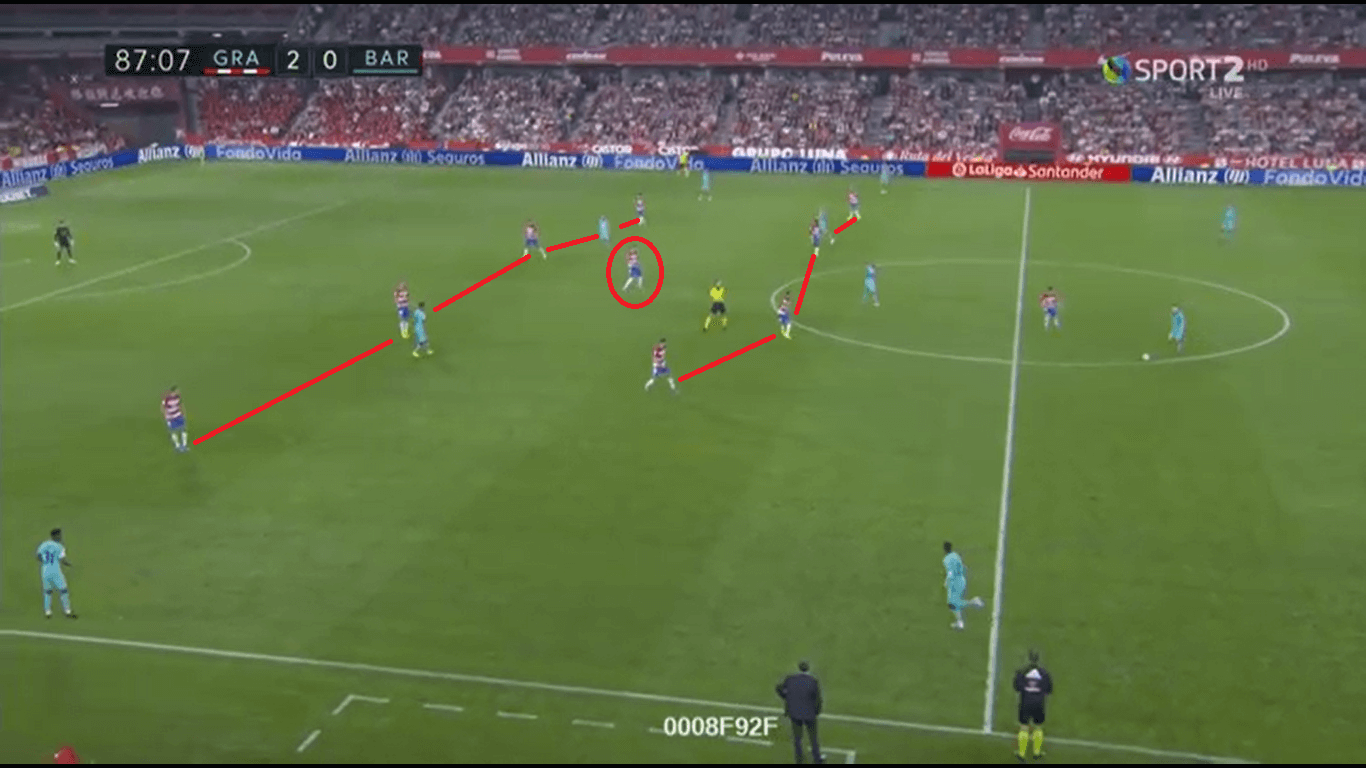
Even though the space between the lines wasn’t that large, the additional man in that space made things more difficult for Barcelona. The downside of this formation was that Granada had only one striker then, which led to a decrease of pressure on Barcelona’s centre-backs. Nonetheless, this did not affect the final score, as Barcelona were not able to score. A penalty in the second half for Granada was converted to a goal and ultimately secured a well-deserved 2-0 win.
Conclusion
The surprising score of this game does not sound surprising anymore after having watched the 90 minutes closely. Our analysis showed that Granada were able to defend very well while Barcelona were unable to find a viable solution. From Granada’s point of view, preventing passes between the lines seemed to be top priority, and with the early goal at hand, they could fully concentrate on that. Barcelona had some moments where they showed promising ideas, but overall their performance was disappointing. If they want to defend their title, they surely need to improve. Granada, on the other hand, may be up for a surprise in this year’s La Liga.

If you love tactical analysis, then you’ll love the digital magazines from totalfootballanalysis.com – a guaranteed 100+ pages of pure tactical analysis covering topics from the Premier League, Serie A, La Liga, Bundesliga and many, many more. Buy your copy of the August issue for just ₤4.99 here




Comments